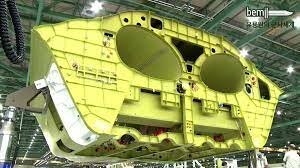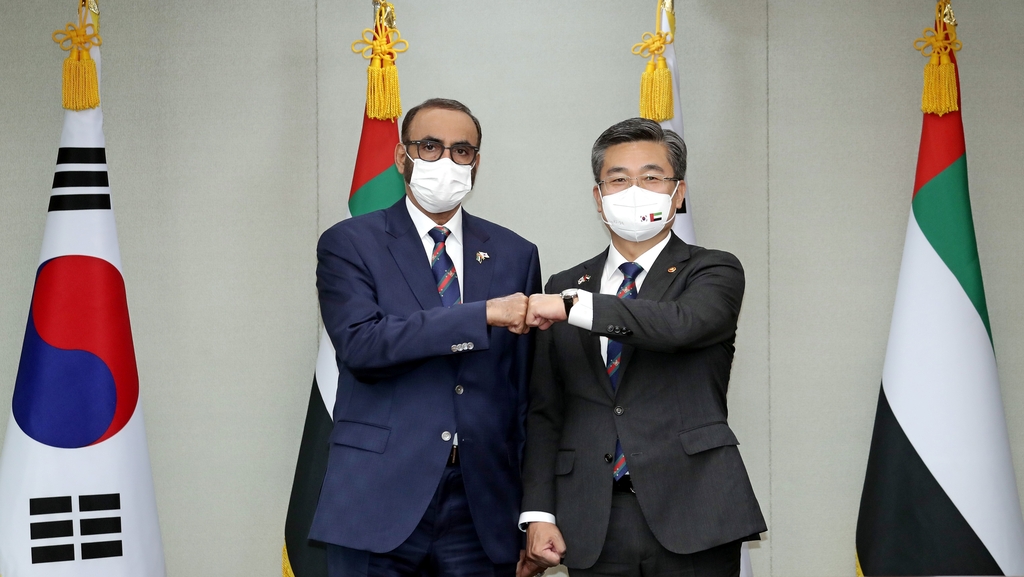- Joined
- 11 February 2010
- Messages
- 1,650
- Reaction score
- 2,703
This new development and progression for Boramae basically makes me have more positive outlook toward life.
You can find them from KAI's brochure.
Any chance you have a front- and side view of the same quality?
You can find them from KAI's brochure.
Any chance you have a front- and side view of the same quality?
I believe it's more about T:W and drag than it is about RCS.Low RCS air superiority configuration:
I think it's still pretty low from front aspect, still good in intercept mission when bogie and us approaching each other.I believe it's more about T:W and drag than it is about RCS.Low RCS air superiority configuration:
Don't want to be eyeballing, but RCS with a nice set of corner reflectors under your wings doesn't work very well.
I make some better resolution pic with available pic online:
Low RCS air superiority configuration:
View attachment 673496
All short-range missiles start from rails. Also, while not strictly a necessity (some 1950s aircraft did indeed carry WVR missiles underneath), the underwing position gives a much better view to the seeker (it actually gets to see upwards).question is.. can the semi recessed bays (which are normally for meteor and amraam?) be used for short range missiles?
All short-range missiles start from rails. Also, while not strictly a necessity (some 1950s aircraft did indeed carry WVR missiles underneath), the underwing position gives a much better view to the seeker (it actually gets to see upwards).question is.. can the semi recessed bays (which are normally for meteor and amraam?) be used for short range missiles?
All short-range missiles start from rails. Also, while not strictly a necessity (some 1950s aircraft did indeed carry WVR missiles underneath), the underwing position gives a much better view to the seeker (it actually gets to see upwards).question is.. can the semi recessed bays (which are normally for meteor and amraam?) be used for short range missiles?
Do externaly mounting 2 short AAM like Iris T increase its RCS that significantly?question is.. can the semi recessed bays (which are normally for meteor and amraam?) be used for short range missiles?
if so, then it would make more sense (for RCS reduction) that two meteors and 2 Iris-T or whatever htey are opting for) be located there instead on the wings
Do externaly mounting 2 short AAM like Iris T increase its RCS that significantly?
Probably low alt.Singapore Airshow 2022: KF-21 captures Asia-Pacific and European export interest | Shephard
KAI has held talks with potential KF-21 fighter jet export customers from Asia-Pacific and Europe.www.shephardmedia.com
Max speed 1400 km/h ?

A spokesperson from KAI told Janes on 21 February that the company is preparing a First Flight Readiness Review (FFRR) and is ensuring the preparedness of components and line-replaceable units (LRUs) for the event.
The KF-21's first flight is scheduled for July, the spokesperson confirmed.
The preparation process is supported by continuing flight trials, undertaken by the KF-21 Combined Test Team (CTT) comprising KAI, the Republic of Korea Air Force (RoKAF), and the country's Defense Acquisition Program Administration (DAPA).
The KAI spokesperson said that by June the CTT will be operating six flyable KF-21 prototypes and two structural prototypes for assessments. Of the six flyable aircraft, four are single-seat and two are twin-seat platforms.
“Following common but essential ground and avionics tests and check-outs, each flyable KF-21 prototype is performing different kinds of trials and evaluations,” said the KAI spokesperson. “For example, if prototype number one undertakes an engine-aircraft compatibility test, prototype number three will undertake a ground vibration test.”
However, following the first flight of the aircraft in July, the testing strategy will change. “After the KF-21's first flight, each prototype will have a different flight mission for evaluation,” said the KAI spokesperson without elaborating.
The spokesperson added that the development of an essential element of the new KF-21 fighter – its AESA radar – has been completed and is now undergoing extensive performance assessments.

KAI prepares for KF-21 first-flight milestone
Korea Aerospace Industries (KAI) is on track to conduct the first flight of its KF-21 Boramae multirole fighter aircraft, buoyed by the completed development of the...www.janes.com
A spokesperson from KAI told Janes on 21 February that the company is preparing a First Flight Readiness Review (FFRR) and is ensuring the preparedness of components and line-replaceable units (LRUs) for the event.
The KF-21's first flight is scheduled for July, the spokesperson confirmed.
The preparation process is supported by continuing flight trials, undertaken by the KF-21 Combined Test Team (CTT) comprising KAI, the Republic of Korea Air Force (RoKAF), and the country's Defense Acquisition Program Administration (DAPA).
The KAI spokesperson said that by June the CTT will be operating six flyable KF-21 prototypes and two structural prototypes for assessments. Of the six flyable aircraft, four are single-seat and two are twin-seat platforms.
“Following common but essential ground and avionics tests and check-outs, each flyable KF-21 prototype is performing different kinds of trials and evaluations,” said the KAI spokesperson. “For example, if prototype number one undertakes an engine-aircraft compatibility test, prototype number three will undertake a ground vibration test.”
However, following the first flight of the aircraft in July, the testing strategy will change. “After the KF-21's first flight, each prototype will have a different flight mission for evaluation,” said the KAI spokesperson without elaborating.
The spokesperson added that the development of an essential element of the new KF-21 fighter – its AESA radar – has been completed and is now undergoing extensive performance assessments.
It is because they wanted to remove all elements that can make development period delayed as far as possible.
not surprised KAI went for the most basic, conservative, and less risky pathIt is because they wanted to remove all elements that can make development period delayed as far as possible.
ive read here that yes it canOne question that I have concerning the Boramae, is that will all kF-21s that will first enter service first with the conformal weapons hard points be upgraded with the internal weapons bay further down the line once full scale production starts?

ive read here that yes it canOne question that I have concerning the Boramae, is that will all kF-21s that will first enter service first with the conformal weapons hard points be upgraded with the internal weapons bay further down the line once full scale production starts?
from this amature eyeball observation.
it seems the semi-recessed panels don't seem too hard to change. its simply covering the bays.
however one concern I have is the paneling itself.. there's not enough serrated edges, etc. I wonder if later versions will change their paneling
and if so, i doubt the early versions can be modified to have these new paneling
View attachment 674944
They may be sold. But even the early blocks are more capable than their F-16 fleet, even the 134 upgraded machines. I don't foresee the early-block KF-21s being sold off before their F-16s.Thanks helmutkohl. So what will happen to the early versions once the later models enter service? I hope that they are sold.
Adding to Stealthflanker - it's worth noting, that for Ukraine=like low-altitude penetration missions, weapons will be hidden by the airframe.Do externaly mounting 2 short AAM like Iris T increase its RCS that significantly?
The conventional design was less money and time to engineer and meets the LO requirements.

UAE showing some interest in the KF-21 and T-50 (despite already ordering the Chinese L-15)

S. Korea, UAE discuss defense industry cooperation | Yonhap News Agency
SEOUL, March 18 (Yonhap) -- South Korea's Defense Minister Suh Wook met his United Ar...en.yna.co.kr
i guess it may ultimately depend on whether the F-35 is approved for UAE. I can see the likelihood being higher if the 35 isnt allowed.UAE showing some interest in the KF-21 and T-50 (despite already ordering the Chinese L-15)

S. Korea, UAE discuss defense industry cooperation | Yonhap News Agency
SEOUL, March 18 (Yonhap) -- South Korea's Defense Minister Suh Wook met his United Ar...en.yna.co.kr
What are the chances that the UAE will become the first export customer for the KF-21? I hope that they do.
The engine's AI-222 from Ivchenko ProgressT-50 (despite already ordering the Chinese L-15)
good point.. think the Chinese will replace it with domestic alternatives?The engine's Al-222 from Ivchenko ProgressT-50 (despite already ordering the Chinese L-15)
i guess it may ultimately depend on whether the F-35 is approved for UAE. I can see the likelihood being higher if the 35 isnt allowed.UAE showing some interest in the KF-21 and T-50 (despite already ordering the Chinese L-15)

S. Korea, UAE discuss defense industry cooperation | Yonhap News Agency
SEOUL, March 18 (Yonhap) -- South Korea's Defense Minister Suh Wook met his United Ar...en.yna.co.kr
What are the chances that the UAE will become the first export customer for the KF-21? I hope that they do.
Also working in the KF-21's favor is the current unpleasantness going on in Ukraine and the likely effect that'll have on the viability of Russian aircraft on the global fighter market. The Russians were already having trouble selling planes as the state of the art advanced and their political position deteriorated; that problem is only likely to get worse and the KF-21 would be in a good position to pick up some of the demand.
Not to mention stimulating demand in Europe for a finite supply of Western aircraft...
Whatever the limits of the KF-21 (F414 notably: american older engines) this place de facto South Korea in a rather interesting position.
